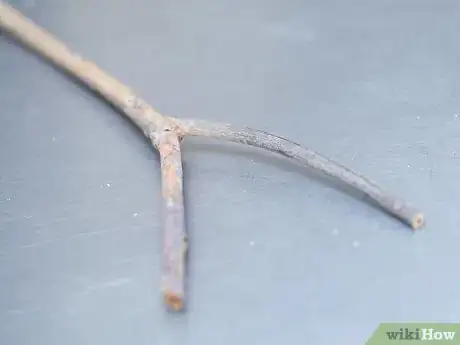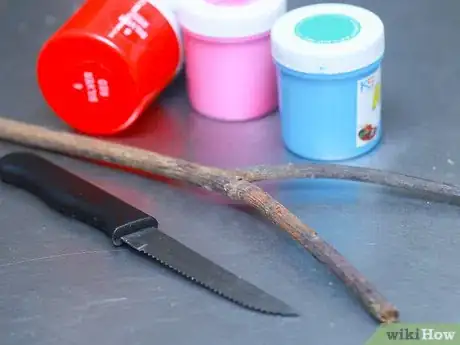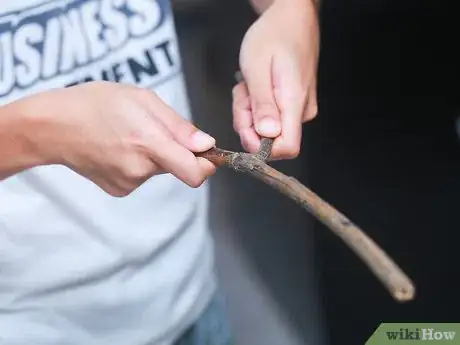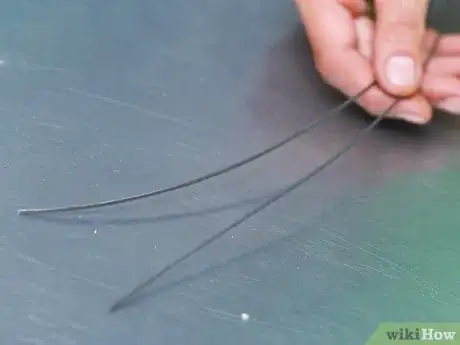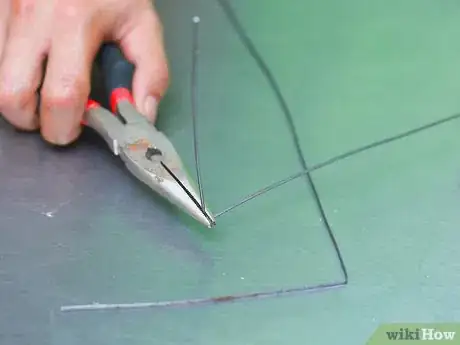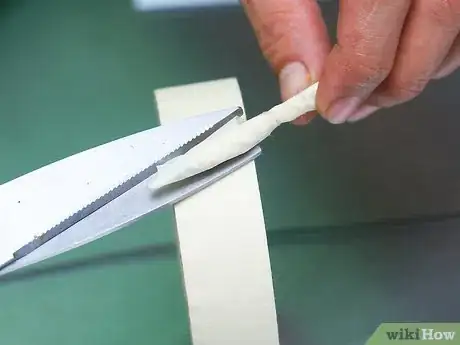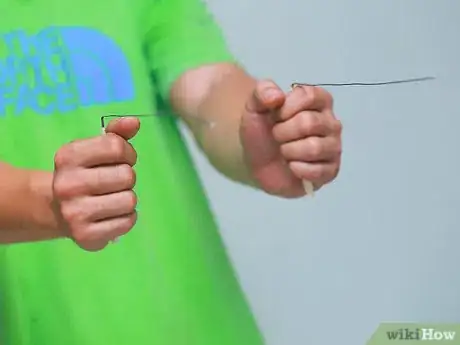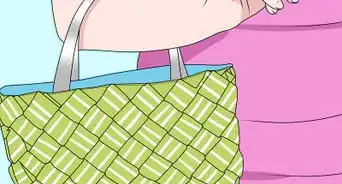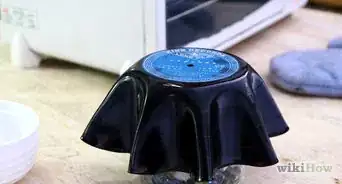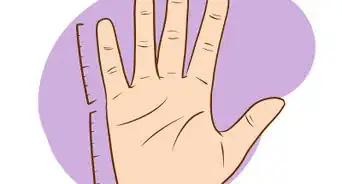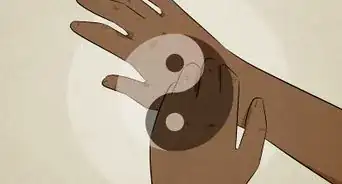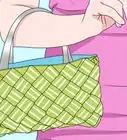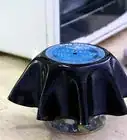This article was co-authored by Jennifer McVey, Cht. Jennifer McVey is a Spiritualist, Seer, and the Spiritual Director of Spiritual Answers and Solutions. With more than 22 years of experience, she specializes in manifesting, ghosts and spirit attachments, hypnotherapy, channeling, and spiritually based life coaching. Jennifer has also published 13 Affirmation Image and six Word Search Puzzle books in spirituality and self-help and has produced over 600 audio sessions.
This article has been viewed 209,854 times.
Divining rods (also known as dowsing rods) can be used to find underground water sources, metal deposits, lost objects, and earth energy lines. Some people use divining rods to converse with the deceased. The classic divining rod is a Y-shaped branch, but many modern dowsers craft their own rods from two L-shaped wires.
Steps
Using a Forked Branch
-
1Find a forked (Y-shaped) branch. This branch can stem from a tree, a bush – any substantial wood source. Search for a branch that is at least a foot long, from tip to tip. Make sure that the forks are relatively equal in length; otherwise, your dowsing rod may be unbalanced.
- Scan the ground for forked twigs that have already broken – perhaps by the passing of a deer, or perhaps by something more mysterious. If you see a perfect Y-shape that is still growing from a tree, feel free to break it off and use it.
- If you break the forked branch from a tree, do it with intention. Don't blindly blunder about, smashing trees to bits. Think about the tree, the surrounding area, and why you are commissioning this dowsing rod. Consider leaving something of your own behind to replace what you have taken from the tree.
-
2Try to find the branch in the same area that you'll be using it. If you're going to be using this dowsing rod to, say, explore an unfamiliar stretch of woods, or look for water in a mysterious valley, try to find your dowsing rod nearby. Look at the brush at the edge of the woods; look for a tree at the rim of the valley. Some dowsers prefer to use branches from particular trees, and many dowsers prefer that their rods are freshly cut.[1]
- Hazel and witch-hazel branches are commonly used in Europe and the U.S., respectively – as are willow and peach-tree cuttings.[2] Most of these branches are popular because they are light and porous: many believe that rods from these trees can better absorb vapors rising from buried metals or water, which weighs down the un-forked end so that it points toward the source.
Advertisement -
3Decorate the dowsing rod. You can use the forked branch as you find it, but you may also consider putting your own mark onto the rod. This is especially fruitful if you plan to use it more than once, or if you plan to give it to someone as a gift. Consider carving patterns into the dowsing rod (carefully!) with a knife, wrapping beads or charms around the wood, or even painting portions of it.
- Consider wrapping fabric around the forks of the rod to make it more comfortable to hold. This can also function as decoration.
-
4Hold one fork in each hand. Point the dowsing rod (the bottom section of the Y) away from you at arm's length. Make sure that the fork is parallel with the ground or tilted very slightly downward. Learn How to Use Dowsing or Divining Rods to get into the right headspace!
Using a Bent Wire
-
1Acquire two equal lengths of wire, each about 20 inches (50.8 cm) long. The wire can be brass, copper, steel – any sturdy but bendable material. For an easy divining rod, try cutting a wire coat hanger into two equal pieces – or straightening two coat hangers by untwisting their hooks.
- Choose the rod material based on purpose and availability. Brass and copper are especially popular because they don't rust. If you have wire fencing or coat hangers readily available, however, it won't hurt to work with what you have.
- Use a strong pair of wire cutters to trim the metal to size. There is no hard, fast rule that the wires must be 20 inches long. Make sure that they are long enough to dip of their own accord, and short enough to hold comfortably.
-
2Bend each wire into an "L" shape. If your wires are 20 inches (50.8 cm) long, make the twist about 5 inches (12.7 cm) from one end. The bend should create a 90-degree angle in the wire. The short leg will become the handle of each rod. The longer legs will dip, cross, and guide you as you approach what you are looking for.
-
3Make handles. The handles should cover the smaller legs of the L-shaped rods – 4-5 inches of the wire, or whatever is comfortable. These handles protect your hands and give you a firmer grip. There is no one way to make a usable handle, so work with what you have available.
- Use a length of 1 inch (2.5 cm) dowel rod, with a hole through the center. Alternately, glue several cotton reels together into a cylinder.
- Use a pen. Remove the innards and caps of two cheap plastic pens, then thread the wire through the pen body. You may also pass the wire through a couple of drinking straws.
- Wrap a rag, a cloth, or a piece of felt around the shorter leg of each "L". Tie the cloth in place with tightly-stretched rubber bands, a piece of twine, or even a safety pin.
-
4Hold one rod in each hand, when dowsing. Hold the wire by the handle (the shorter leg of the "L") so that the long part is parallel with the ground. Make sure to hold the dowsing rods loosely enough that they can swing freely from side to side. Hold the rods at arms length away from the body and about 9 inches apart. Remember to keep the rods parallel with the ground or tipped very slightly downward. Learn How to Use Dowsing or Divining Rods to find what you need to find.
- The rod should rest flat over the index finger, while the butt of the handle should fit into the heel of your hand.
- Do not grip the handles, as the rods must float freely to work. You may, however, close your hand slightly to improve stability.
Community Q&A
-
QuestionCan I use an old extendable portable TV antenna for a dowsing rods?
 Community AnswerYes, you can. Antennas are great for this purpose.
Community AnswerYes, you can. Antennas are great for this purpose. -
QuestionWhy do witches use these?
 Community AnswerThe term "water witching" actually has nothing to do with witches, although they might use a dowsing rod to determine where water or minerals are located on a property. However, water "witching" was most often done using a branch cut from a witch hazel tree or shrub, which is where the word "witch" comes from in this context.
Community AnswerThe term "water witching" actually has nothing to do with witches, although they might use a dowsing rod to determine where water or minerals are located on a property. However, water "witching" was most often done using a branch cut from a witch hazel tree or shrub, which is where the word "witch" comes from in this context. -
QuestionHow do you get rid of negative energy using a dowsing rod?
 Community Answerit varies, depending on your faith and who or what you are dealing with. Dowsing rods will not help clear negativity, but might help you communicate with such energies, or figure out their source.
Community Answerit varies, depending on your faith and who or what you are dealing with. Dowsing rods will not help clear negativity, but might help you communicate with such energies, or figure out their source.
Warnings
- Consider covering the tips of the wire to prevent injurious poking. At any rate, be cautious not to point sharp wires directly toward anyone.⧼thumbs_response⧽
- Be careful of how much faith you place in your dowsing rod. These rods are great for exploring your local woods and searching for unseen forces, but they may not hold up in certain high-pressure situations that you'll encounter in the modern world.⧼thumbs_response⧽
About This Article
Divining rods, also known as dowsing rods, have been thought to help people to find things like underground water sources, lost objects, and energy lines. You can use either a forked tree branch or 2 bent wires as dowsing rods. If you’re using a branch, look for one shaped like the letter Y so you can hold the 2 forked sides and point the other end at the ground. If you’re using wires, you’ll want to bend the ends of each one into an L shape and wrap the small ends in rags or cloths to make handles. You’ll need to hold one wire in each hand. In folklore, the way to use dowsing rods is to hold your stick or wires in front of you and let them guide you to lost or valuable things. For more tips, including how to decorate your dowsing rods, read on!
